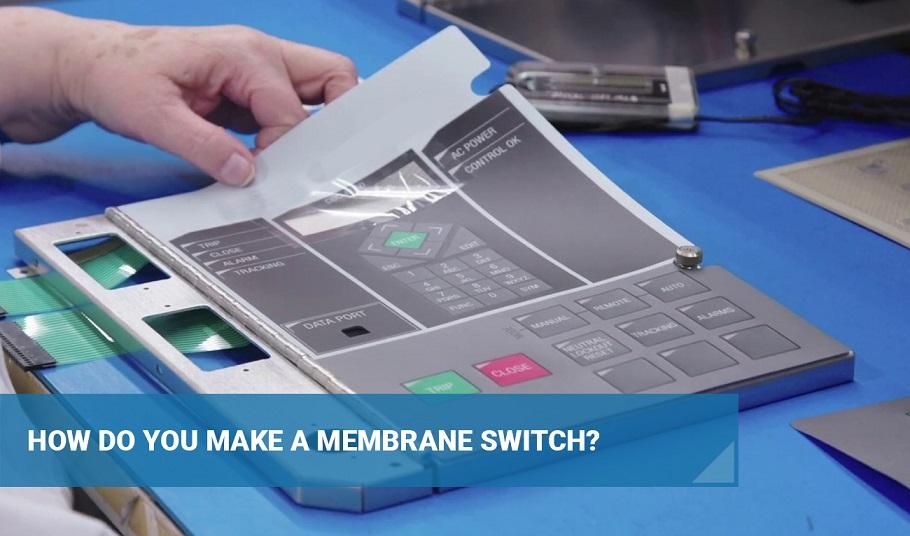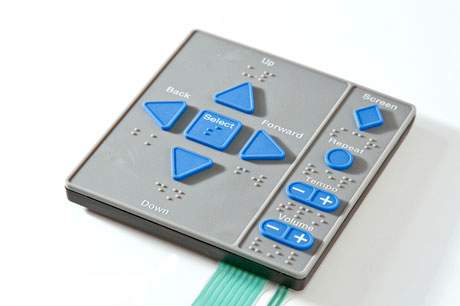Unique Designs by a Professional Membrane Switch Manufacturer
Unique Designs by a Professional Membrane Switch Manufacturer
Blog Article
Comprehending the Relevance of Membrane Switch in Modern Electronics and Their Applications
Membrane switches serve as a crucial component in modern electronics, using a reliable user interface for customer communication. Their light-weight and customizable nature makes them suitable for a variety of applications across diverse industries. Understanding their essential elements and advantages can offer insights into their growing relevance. As technology continues to advance, the evolution of Membrane switches over increases concerns regarding their future applications and design developments. What lies in advance in this vibrant field?

What Are Membrane Switches?
Membrane buttons are essential components in modern electronic devices, working as interface that assist in interaction between tools and customers. These buttons include several layers, consisting of a visuals overlay, a sticky layer, and a circuit layer, all of which collaborate to develop a functional and sturdy user interface. The style permits a level, inconspicuous solution that can be tailored relating to size, form, and visual look, making them suitable for numerous applications, from consumer electronic devices to clinical devices. The responsive responses given by Membrane switches over improves user experience, while their resistance to dirt and wetness makes them perfect for testing atmospheres. Membrane buttons can incorporate functions such as backlighting and printed graphics, additionally expanding their functionality. Their versatility and toughness make them a recommended choice in sectors where reliability and simplicity of usage are paramount, eventually adding to the seamless operation of modern-day electronic devices.
Secret Elements of Membrane Changes
While different parts contribute to the performance of a membrane layer button, three primary layers play considerable duties in its layout and operation. The top layer, normally made from a durable polymer, serves as the interface for individual communication, often featuring printed graphics and symbols. Under this is the spacer layer, which keeps the essential distance between the leading layer and the circuit layer. This spacer layer assurances that the switch activates just when pressed, stopping unintentional inputs. Ultimately, the circuit layer contains conductive traces that complete the electrical circuit when the leading layer is dispirited. These traces can be made from numerous products, including copper or silver. Together, these parts develop a trustworthy and robust device that is compact and functional, suitable for a vast array of digital applications, from house devices to clinical gadgets. Comprehending these essential components is vital for valuing the general performance of Membrane buttons.
Benefits of Using Membrane Changes

Membrane Switch Production Process
Understanding the Membrane switch manufacturing procedure discloses the intricate steps associated with creating these essential components. The process usually starts with the layout phase, where formats and requirements are developed using specialized software. Following this, the graphic overlay is published on a versatile substrate, often utilizing high-resolution printing strategies to guarantee clearness and precision.Next, the sticky layers are used, which serve to bond the different components together. The circuit layers, made from conductive inks or products, are after that published onto a separate substrate. These layers are carefully aligned and laminated flooring to develop a functional switch.After setting up, the buttons go through evaluating to verify functionality and durability. Quality assurance procedures are carried out throughout the process to identify and fix any kind of problems. Finally, the finished Membrane switches are packaged and planned for distribution, ready to fulfill the demands of modern digital applications.
Applications of Membrane Changes in Various Industries
Membrane buttons are progressively utilized throughout various markets, particularly in clinical equipment and customer electronic devices. In the medical area, they offer trusted control interfaces for tools that require specific operation. In consumer electronic devices, these switches improve customer interaction by using responsive and smooth user interfaces.
Medical Equipment Control
Many modern-day medical devices use Membrane buttons for structured operation and improved individual interaction. These buttons supply hop over to these guys a dependable, long lasting user interface for a selection of applications, consisting of diagnostic equipment, client tracking systems, and medical tools. Their adjustable layouts enable certain layouts that can accommodate the one-of-a-kind requirements of health care specialists, making certain intuitive navigating and efficient accessibility to important functions. Additionally, Membrane switches are immune to impurities, making them ideal for clean and sterile settings. The responsive feedback they offer can boost customer self-confidence, lowering the danger of errors during vital clinical treatments. Generally, the combination of Membrane buttons in clinical devices significantly adds to boosted functional effectiveness and client safety in medical care setups.
Consumer Electronic Devices Interfaces
In the domain name of consumer electronic devices, Membrane switches play a crucial duty in improving interface throughout a vast array of devices. These buttons are essential to items such as push-button controls, microwaves, and gaming consoles, giving a straightforward and effective interface. Their style permits a seamless integration of graphics and performance, enabling makers to create smooth, modern appearances without jeopardizing use. Membrane buttons are also understood for their durability, commonly enduring considerable use and exposure to numerous environmental problems. Additionally, they can incorporate functions like backlighting and responsive feedback, further enhancing the customer experience. As consumer demands for advanced yet instinctive user interfaces grow, Membrane changes proceed to be an important element beforehand digital tool functionality.
Style Factors To Consider for Membrane Switches Over
Creating effective Membrane switches requires cautious interest to numerous factors that influence both functionality and user experience. One important factor to consider is the option of products, as they can influence durability, tactile feedback, and aesthetic appeal. Choosing an appropriate adhesive is vital for ensuring long-term attachment and resistance to ecological factors.In enhancement, the format and design of the button have to suit individual communication, with switch dimensions and basics spacing optimized for ease of usage. The consolidation of graphics and labeling should prioritize clarity and presence under numerous illumination conditions.Consideration of electric characteristics, such as actuation pressure and button sensitivity, will improve the responsiveness of the Membrane switch. Additionally, the style should fit producing processes to guarantee cost-effectiveness and timely manufacturing. Overall, a well-balanced style enhances both the performance and the user experience of Membrane switches in modern electronics.

Future Fads in Membrane Switch Technology
As innovation remains to progress, Membrane buttons are poised to integrate brand-new innovations that will certainly improve their performance and application in different areas. One considerable pattern is the unification of durable and flexible materials, which will increase the lifespan and dependability of these buttons. Improved surface appearances and customizable graphics are additionally prepared for, enabling more intuitive customer interfaces.Moreover, the assimilation of wise modern technology, such as touch-sensitive surfaces and haptic comments, is anticipated to improve customer communication, making Membrane changes much more interesting and responsive. Additionally, developments in published electronics will certainly make it possible for extra complex wiring within thinner accounts, additionally increasing design possibilities.Sustainability will additionally play a vital role in future advancements, as suppliers check out environmentally friendly products and production procedures. Overall, these fads will certainly ensure that Membrane switches remain appropriate and essential in a significantly digital and interconnected globe.
Often Asked Concerns
Just How Do Membrane Switches Over Compare to Standard Mechanical Switches?
Membrane changes deal advantages over conventional mechanical switches, consisting of reduced size, lighter weight, and boosted longevity. They generally supply a secured surface area, improving resistance to dust and wetness, making them suitable for varied applications.
What Materials Are Commonly Made Use Of in Membrane Switch Construction?

Can Membrane Switches Over Withstand Extreme Environmental Conditions?
Membrane switches can endure severe ecological conditions, relying on their style and materials. Top notch building and constructions typically feature resilience versus temperature level changes, moisture, and direct exposure to chemicals, making them suitable for different requiring applications throughout sectors.
How Much Time Do Membrane Changes Generally Last Before Failure?
Membrane switches commonly exhibit a life-span varying from 1 to 10 million actuations, relying on aspects such as usage frequency, ecological conditions, and producing high quality. Routine upkeep can expand their durability and functional dependability considerably.
Are Membrane Switches Over Personalized for Certain Applications?
Membrane buttons are without a doubt adjustable for particular applications. They can be customized in design, size, and capability, permitting suppliers to satisfy one-of-a-kind individual requirements and boost item looks while maintaining operational performance and toughness. Membrane buttons are important elements in modern-day electronics, serving as individual interfaces that assist in interaction in between users and devices. The responsive responses offered by Membrane switches boosts user experience, while their resistance to dust and wetness makes them optimal for challenging settings. The unification of graphics and labeling need to prioritize clearness and presence under various illumination conditions.Consideration of electric qualities, such as actuation force and button level of sensitivity, will certainly enhance the responsiveness of the Membrane button. Boosted surface area appearances and adjustable graphics are additionally anticipated, enabling for even more user-friendly customer interfaces.Moreover, the assimilation of wise innovation, such as touch-sensitive surface areas and haptic responses, is expected to enhance customer interaction, making Membrane changes a lot more receptive and appealing. Membrane switches deal benefits over typical mechanical buttons, including minimized size, lighter weight, and improved official source resilience.
Report this page